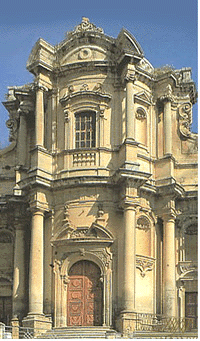...Best of Sicily presents... Best of Sicily Magazine. ... Dedicated to Sicilian art, culture, history, people, places and all things Sicilian. |
by Carlo Trabia | |||
Magazine Index Best of Sicily Arts & Culture Fashion Food & Wine History & Society About Us Travel Faqs Contact Map of Sicily
|
In Italy the Baroque period began late in the 1500s. In Sicily, however, it was introduced later. The movement emerged between the Mannerist and Rococo periods, and in Sicily continued as a predominant form well into the eighteenth century, imitating Spanish as well as Italian styles. Its identification with the Counter Reformation is beyond doubt, but in Sicily (as in Spain and peninsular Italy) the Baroque is encountered in residential architecture (palaces) as much as ecclesiastical buildings (churches and monasteries). Painting, music and even philosophy also expressed the Baroque spirit, with its emphasis on glorification of the human (and Divine) spirit. The term itself may derive from the Portuguese word barroco for an irregularly-shaped pearl, an obvious reference to the ornate sculptural motifs typical of Baroque architecture. It is quite possible that the Baroque may not have fully developed without the influence of the Renaissance, the most important medieval styles being the Romanesque and, subsequently, the Gothic (whose purest form never made serious inroads into Sicilian architecture). "Proto-Baroque" forms are evident in the work of Michelangelo, while Bernini's work is almost exclusively Baroque in style. Baroque churches are typified by wide naves and, compared to Gothic structures, rather low ceilings crowned by high cupolas (domes). Ragusa and Noto are famous for their Baroque architecture. Catania's old district is almost entirely Baroque, and most Sicilian cities boast numerous Baroque structures. While many of Sicily's churches and palazzi built in the eighteenth century are more properly described as Rococo, their style is often a close approximation of the pure Baroque. This is even true of the sculptural work of Giacomo Serpotta. Volumes have been written about the Baroque in Sicily, and it's a fascinating study - and too vast to be done justice here. Because the Catholic Church came to regard the Baroque as the epitome of artistic expression and the glorification of God, an unfortunate effort to redesign medieval churches into Baroque ones was born. Palermo Cathedral suffered this fate, and so did many smaller churches built during the Norman and Swabian periods. Some have been restored to their former (original) states, though this has met with varying degrees of success. Following the earthquake which virtually destroyed a number of southeastern towns (Noto, Ragusa) and damaged Catania in 1693, new street plans were developed and a number of churches and palaces were built in a novel "Sicilian Baroque" style which to some extent departed from the movements then prevalent in Rome, Madrid and even Sicily. Therefore, a degree of stylistic distinction may be drawn between the products of this new Baroque movement and the structures erected in Catania following the volcanic eruption of 1669 which destroyed most of that city. The Sicilian Baroque movement reached its height in the 1740s, but within a few decades the Neo-Classical movement was becoming popular, and the facades and naves of some new (or restored) churches actually featured elements of both styles. Most of Sicily's Norman-Arab and Romanesque-Gothic churches were built to be viewed in their entirety, from every imaginable angle, inside and out. Many of the Baroque ones, however, were constructed with splendid facades and interiors but --especially in larger cities-- minimal decoration of the exterior side or rear (apse) areas, as if they were part of a theatrical stage. And in a certain sense they probably were the physical representation of a society's phantom wealth. We cannot ignore the stark reality that both Church and Aristocracy pursued an ambitious and costly building programme at a time when the masses lived in poverty, illiteracy and neglect. As recently as the late 1890s, Palermo's Neo-Classical Massimo opera house, then the world's largest, was constructed in a city which lacked a proper public hospital. It has been suggested, therefore, that the "golden age" of the Sicilian Baroque (and the movement following it) represented a blatant form of extravagance. The same has been said of mainland Italy --ruled by the same Bourbon dynasty after 1734-- where the monumental Royal Palace of Caserta (outside Naples) designed by Luigi Vanvitelli was erected in the 1750s. Fortunately, these splendid buildings remain while the memory of mass poverty has been banished to the realm of history. With its aristocratic pretensions and Counter-Reformist implications, the Baroque came to epitomise power and wealth as few previous movements ever had. The Baroque is a style that many observers either love or hate. Indifference is rare, and in church architecture there exists a subtle rivalry between the Gothic and Baroque camps --sometimes an expression of Protestant versus Catholic sentiment, though in some countries a kind of aesthetic truce has been achieved. Compromises can be bizarre. Palermo's largest Jesuit church, Casa Professa, is a masterpiece of complex Baroque lines and ornate Rococo stone inlay, but the recent addition of stained-glass windows (a "Gothic" element absent from most Baroque churches whose majesty relies on unfiltered sunlight) creates an overwhelming effect beyond the imagination of even the most adamant proponents of the Baroque. Nevertheless, the Baroque lives. About the Author: Architect Carlo Trabia has written for this publication and others. | ||
Top of Page |
 The Baroque art and architecture of Sicily may not constitute a distinct
style within the Baroque movement (as some have said), but they reflect a regionalisation evident
in many parts of Europe. Local trends of this kind become parts of local
culture.
The Baroque art and architecture of Sicily may not constitute a distinct
style within the Baroque movement (as some have said), but they reflect a regionalisation evident
in many parts of Europe. Local trends of this kind become parts of local
culture.